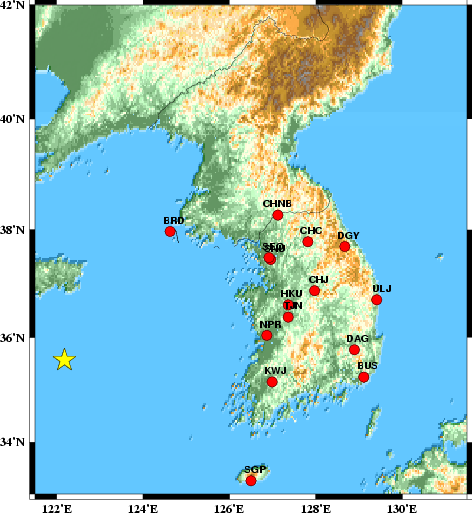
2002/07/23 12:48:04 35.57N 122.18E 9 4.80 Korea
SLU Moment Tensor Solution
2002/07/23 12:48:04 35.57N 122.18E 9 4.80 Korea
Best Fitting Double Couple
Mo = 2.19e+23 dyne-cm
Mw = 4.86
Z = 17 km
Plane Strike Dip Rake
NP1 202 81 -20
NP2 295 70 -170
Principal Axes:
Axis Value Plunge Azimuth
T 2.19e+23 7 250
N 0.00e+00 68 358
P -2.19e+23 21 157
Moment Tensor: (dyne-cm)
Component Value
Mxx -1.35e+23
Mxy 1.39e+23
Mxz 5.75e+22
Myy 1.59e+23
Myz -5.45e+22
Mzz -2.44e+22
--------------
-----------------#####
-------------------#########
-------------------###########
--------------------##############
--------------------################
##########----------##################
##################--####################
###################---##################
####################-------###############
###################-----------############
##################--------------##########
#################------------------#######
#############--------------------####
T ############----------------------###
############------------------------
############------------------------
###########-----------------------
########------------ -------
#######------------ P ------
####------------ ---
--------------
Harvard Convention
Moment Tensor:
R T F
-2.44e+22 5.75e+22 5.45e+22
5.75e+22 -1.35e+23 -1.39e+23
5.45e+22 -1.39e+23 1.59e+23
|
The focal mechanism was determined using broadband seismic waveforms. The location of the event and the station distribution are given in Figure 1.

|
|
|
STK = 295
DIP = 70
RAKE = -170
MW = 4.86
HS = 17
This is not a well determined mechanism. The moment is well constrained, but the mechanism is not. The surface-wave inversion is preferred. This was difficult to model because of the high frequency coda following the surface wave - hence the relatively low frequency bandpass filter corner. The P-wave first motions were marginal and of no assistance in determining the solutions. The crossing nodal planes in the NE quadrant would give low P-wave amplitudes to Korea. The Love wave radiation pattern data are superb.
The program wvfgrd96 was used with good traces observed at short distance to determine the focal mechanism, depth and seismic moment. This technique requires a high quality signal and well determined velocity model for the Green functions. To the extent that these are the quality data, this type of mechanism should be preferred over the radiation pattern technique which requires the separate step of defining the pressure and tension quadrants and the correct strike.
The observed and predicted traces are filtered using the following gsac commands:
hp c 0.01 4 lp c 0.06 4The results of this grid search from 0.5 to 19 km depth are as follow:
DEPTH STK DIP RAKE MW FIT
WVFGRD96 0.5 205 75 35 4.66 0.3981
WVFGRD96 1.0 195 85 5 4.59 0.4230
WVFGRD96 2.0 20 90 0 4.63 0.4472
WVFGRD96 3.0 20 85 5 4.66 0.4677
WVFGRD96 4.0 25 80 20 4.72 0.4873
WVFGRD96 5.0 200 85 -25 4.74 0.5121
WVFGRD96 6.0 200 85 -30 4.76 0.5312
WVFGRD96 7.0 200 85 -30 4.77 0.5448
WVFGRD96 8.0 200 80 -30 4.79 0.5554
WVFGRD96 9.0 200 80 -30 4.79 0.5615
WVFGRD96 10.0 200 80 -25 4.80 0.5653
WVFGRD96 11.0 200 80 -25 4.80 0.5670
WVFGRD96 12.0 200 80 -25 4.80 0.5639
WVFGRD96 13.0 200 85 -20 4.80 0.5607
WVFGRD96 14.0 200 85 -20 4.81 0.5572
WVFGRD96 15.0 200 85 -20 4.81 0.5555
WVFGRD96 16.0 200 85 -20 4.81 0.5518
WVFGRD96 17.0 200 85 -20 4.82 0.5459
WVFGRD96 18.0 200 85 -20 4.82 0.5429
WVFGRD96 19.0 200 85 -20 4.83 0.5384
WVFGRD96 20.0 200 85 -20 4.84 0.5357
WVFGRD96 21.0 200 85 -20 4.84 0.5323
WVFGRD96 22.0 200 85 -15 4.86 0.5291
WVFGRD96 23.0 200 85 -15 4.87 0.5280
WVFGRD96 24.0 200 85 -15 4.88 0.5278
WVFGRD96 25.0 200 80 -15 4.89 0.5283
The best solution is
WVFGRD96 11.0 200 80 -25 4.80 0.5670
The mechanism correspond to the best fit is

|
|
|
The best fit as a function of depth is given in the following figure:

|
|
|
The comparison of the observed and predicted waveforms is given in the next figure. The red traces are the observed and the blue are the predicted. Each observed-predicted componnet is plotted to the same scale and peak amplitudes are indicated by the numbers to the left of each trace. The number in black at the rightr of each predicted traces it the time shift required for maximum correlation between the observed and predicted traces. This time shift is required because the synthetics are not computed at exactly the same distance as the observed and because the velocity model used in the predictions may not be perfect. A positive time shift indicates that the prediction is too fast and should be delayed to match the observed trace (shift to the right in this figure). A negative value indicates that the prediction is too slow. The bandpass filter used in the processing and for the display was
hp c 0.01 4 lp c 0.06 4

|
|
|

|
| Focal mechanism sensitivity at the preferred depth. The red color indicates a very good fit to thewavefroms. Each solution is plotted as a vector at a given value of strike and dip with the angle of the vector representing the rake angle, measured, with respect to the upward vertical (N) in the figure. |
NODAL PLANES
STK= 201.53
DIP= 80.60
RAKE= -20.28
OR
STK= 294.98
DIP= 70.00
RAKE= -169.99
DEPTH = 18.0 km
Mw = 4.80
Best Fit 0.8644 - P-T axis plot gives solutions with FIT greater than FIT90
 |
The P-wave first motion data for focal mechanism studies are as follow:
Sta Az(deg) Dist(km) First motion BRD 39 344 eP_X SES 69 407 eP_- NPR 82 427 eP_+ KWJ 95 440 eP_+ SGP 122 473 eP_X SEO 62 475 eP_- SNU 63 476 eP_X TJN 78 476 eP_+ HKU 75 481 eP_X SSE 191 505 iP_+ CHNB 54 533 eP_- CHJ 73 541 eP_+ CHC 62 560 eP_- DAG 86 608 eP_+ DGY 66 627 eP_X BUS 91 631 eP_X ULJ 77 662 eP_- BJT 315 724 eP_X
Surface wave analysis was performed using codes from Computer Programs in Seismology, specifically the multiple filter analysis program do_mft and the surface-wave radiation pattern search program srfgrd96.
Digital data were collected, instrument response removed and traces converted
to Z, R an T components. Multiple filter analysis was applied to the Z and T traces to obtain the Rayleigh- and Love-wave spectral amplitudes, respectively.
These were input to the search program which examined all depths between 1 and 25 km
and all possible mechanisms.

|
|
|

|
| Pressure-tension axis trends. Since the surface-wave spectra search does not distinguish between P and T axes and since there is a 180 ambiguity in strike, all possible P and T axes are plotted. First motion data and waveforms will be used to select the preferred mechanism. The purpose of this plot is to provide an idea of the possible range of solutions. The P and T-axes for all mechanisms with goodness of fit greater than 0.9 FITMAX (above) are plotted here. |

|
| Focal mechanism sensitivity at the preferred depth. The red color indicates a very good fit to the Love and Rayleigh wave radiation patterns. Each solution is plotted as a vector at a given value of strike and dip with the angle of the vector representing the rake angle, measured, with respect to the upward vertical (N) in the figure. Because of the symmetry of the spectral amplitude rediation patterns, only strikes from 0-180 degrees are sampled. |
The distribution of broadband stations with azimuth and distance is
Sta Az(deg) Dist(km) BRD 39 344 NPR 82 427 KWJ 95 440 SGP 122 473 SEO 62 475 SNU 63 476 TJN 78 476 HKU 75 481 SSE 191 505 CHNB 54 532 CHJ 73 541 CHC 62 560 DAG 86 608 DGY 66 627 BUS 91 631 ULJ 77 662 BJT 315 724 XAN 266 1224
Since the analysis of the surface-wave radiation patterns uses only spectral amplitudes and because the surfave-wave radiation patterns have a 180 degree symmetry, each surface-wave solution consists of four possible focal mechanisms corresponding to the interchange of the P- and T-axes and a roation of the mechanism by 180 degrees. To select one mechanism, P-wave first motion can be used. This was not possible in this case because all the P-wave first motions were emergent ( a feature of the P-wave wave takeoff angle, the station location and the mechanism). The other way to select among the mechanisms is to compute forward synthetics and compare the observed and predicted waveforms.
The fits to the waveforms with the given mechanism are show below:
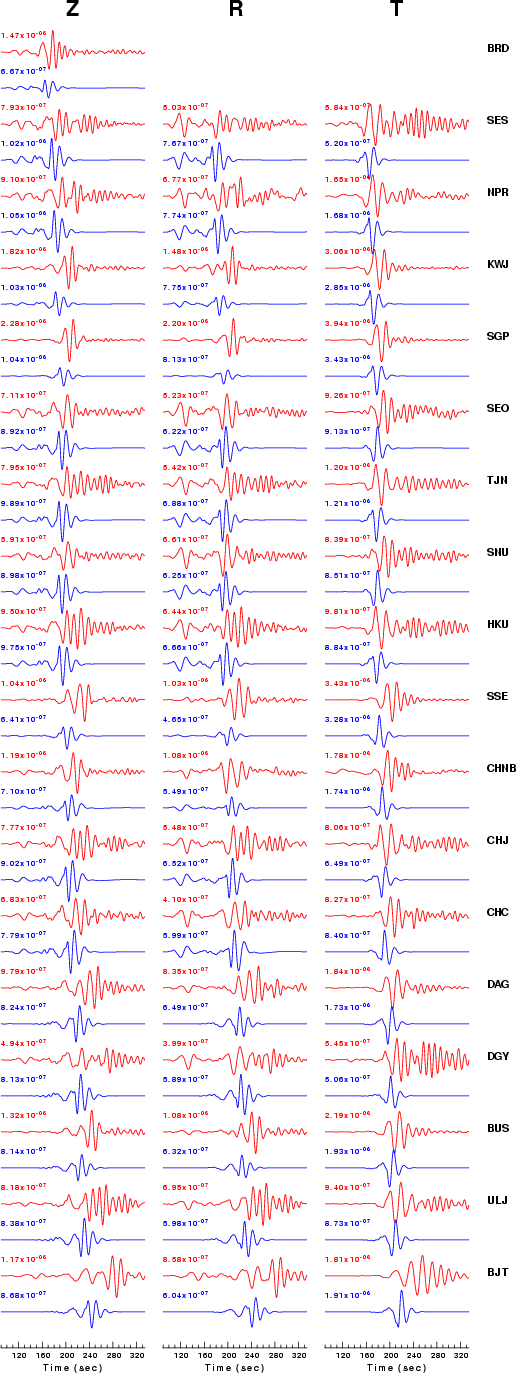
|
This figure shows the fit to the three components of motion (Z - vertical, R-radial and T - transverse). For each station and component, the observed traces is shown in red and the model predicted trace in blue. The traces represent filtered ground velocity in units of meters/sec (the peak value is printed adjacent to each trace; each pair of traces to plotted to the same scale to emphasize the difference in levels). Both synthetic and observed traces have been filtered using the SAC commands:
hp c 0.01 4 lp c 0.06 4

|

|
The figures below show the observed spectral amplitudes (units of cm-sec) at each station and the
theoretical predictions as a function of period for the mechanism given above. The modified Utah model earth model
was used to define the Green's functions. For each station, the Love and Rayleigh wave spectrail amplitudes are plotted with the same scaling so that one can get a sense fo the effects of the effects of the focal mechanism and depth on the excitation of each.
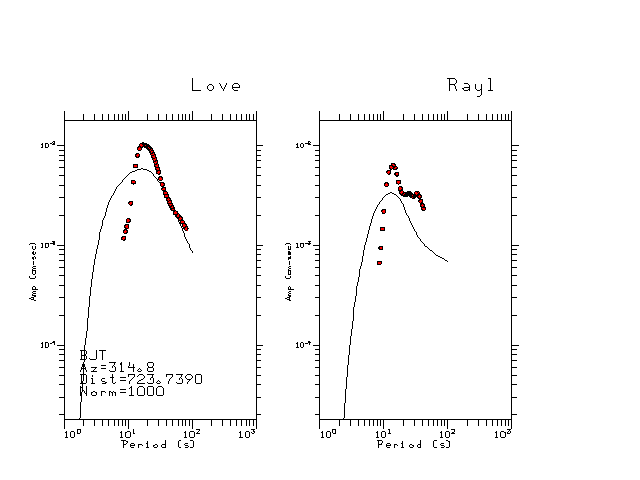 |
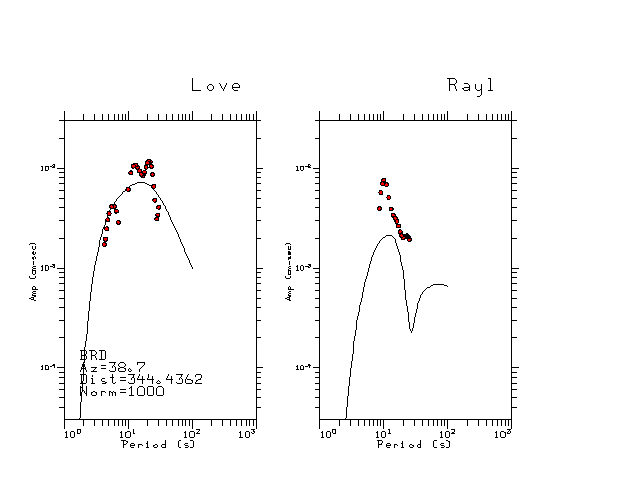 |
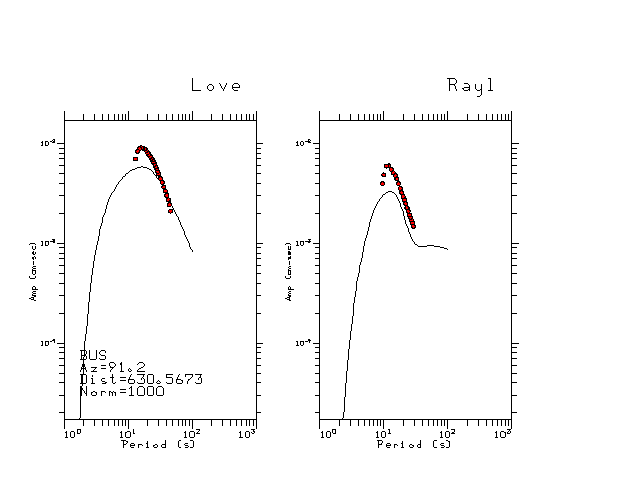 |
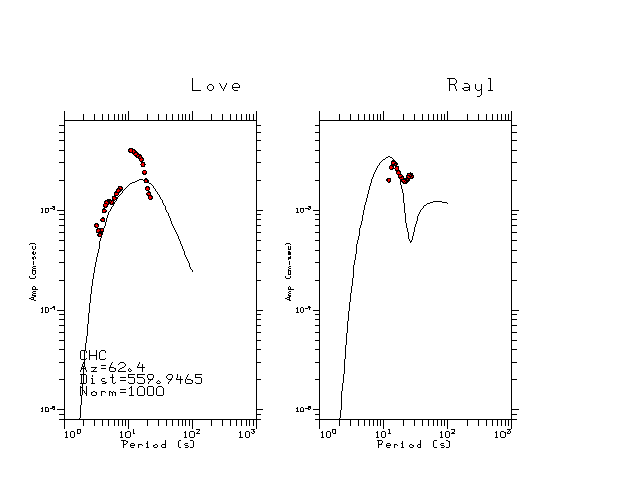 |
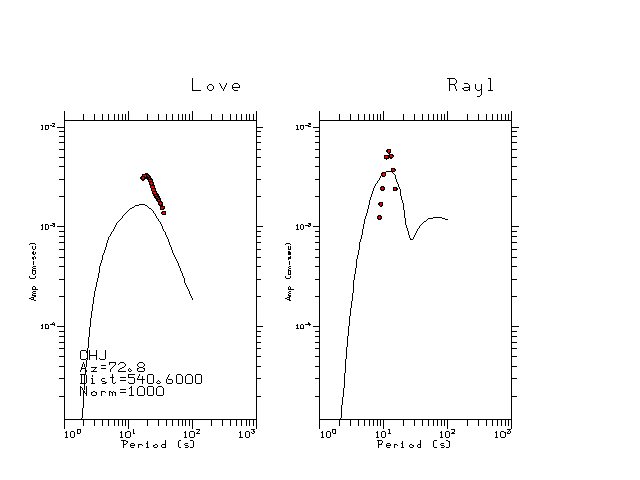 |
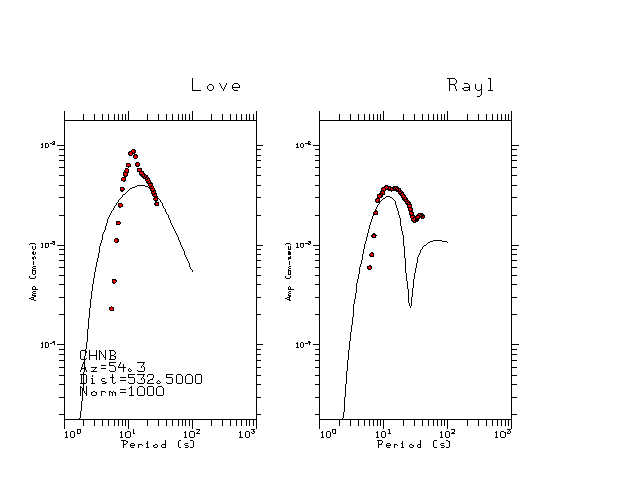 |
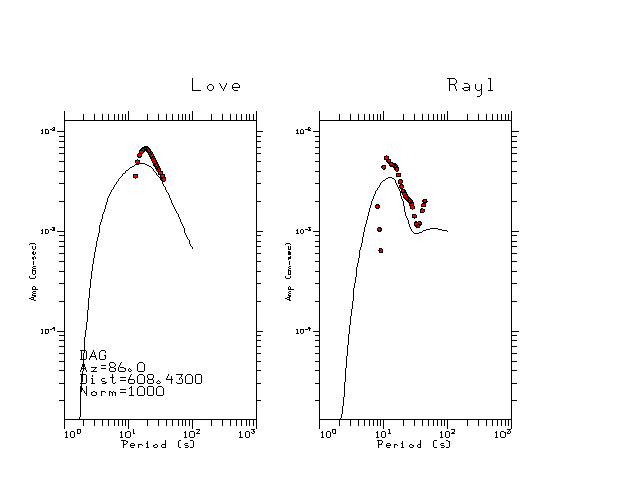 |
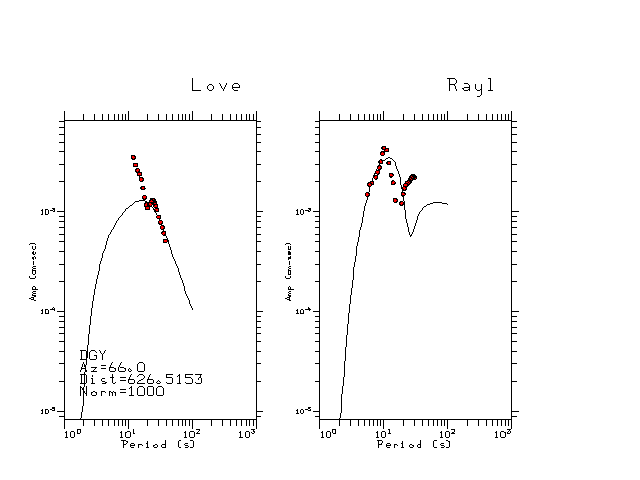 |
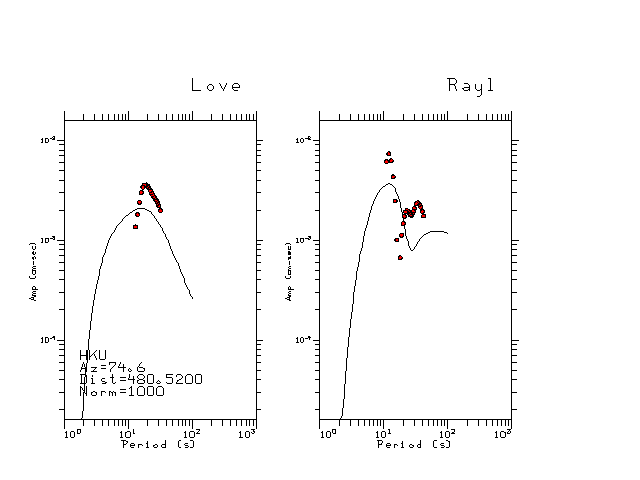 |
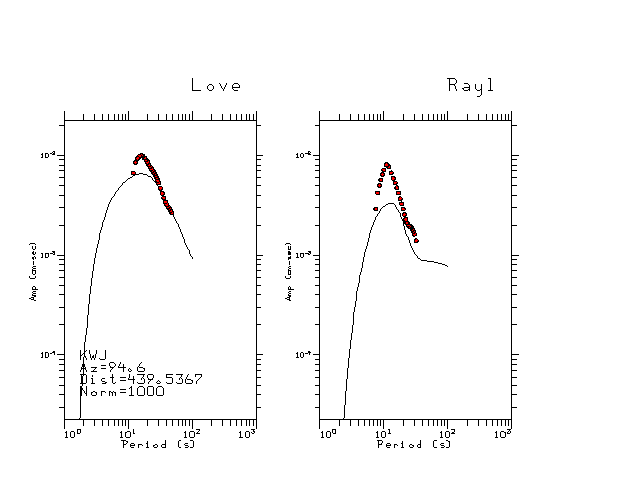 |
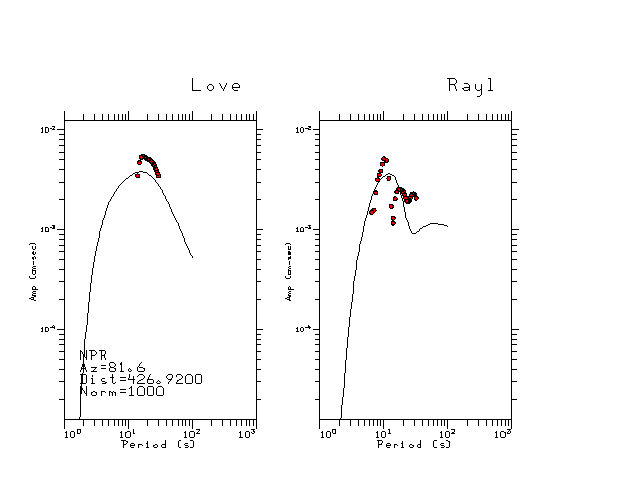 |
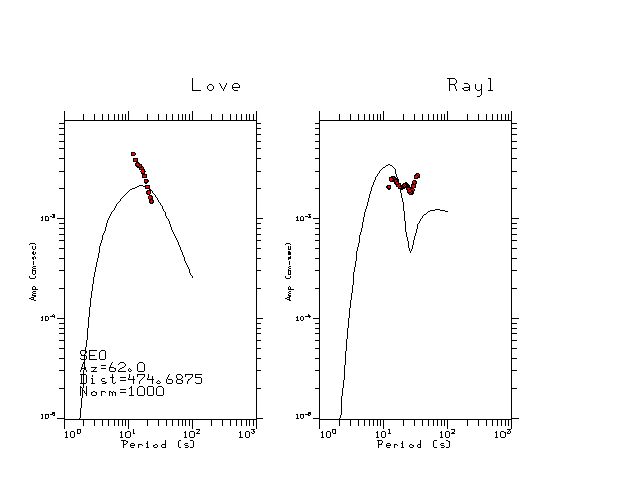 |
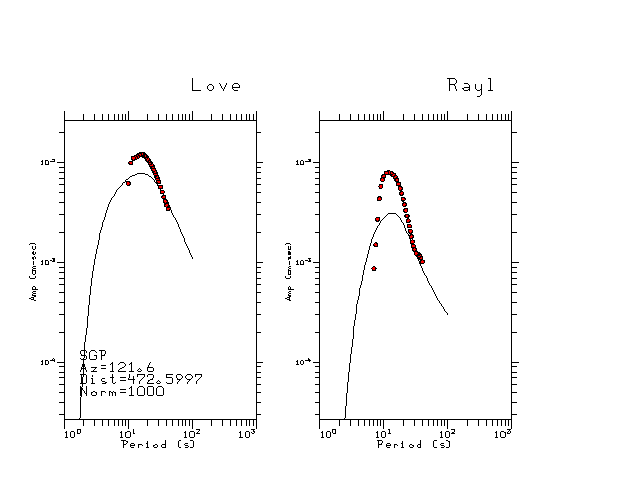 |
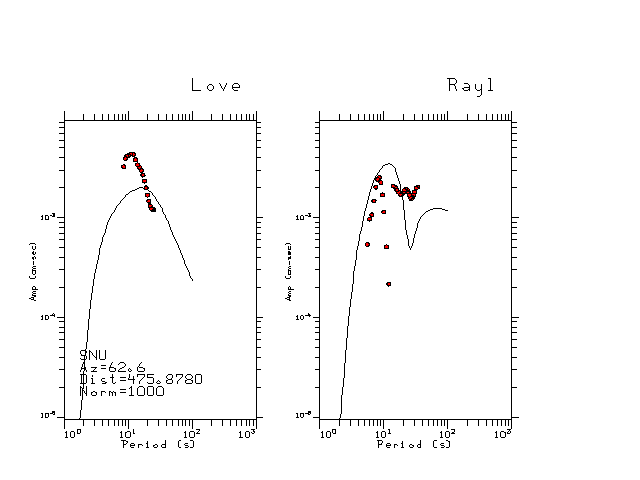 |
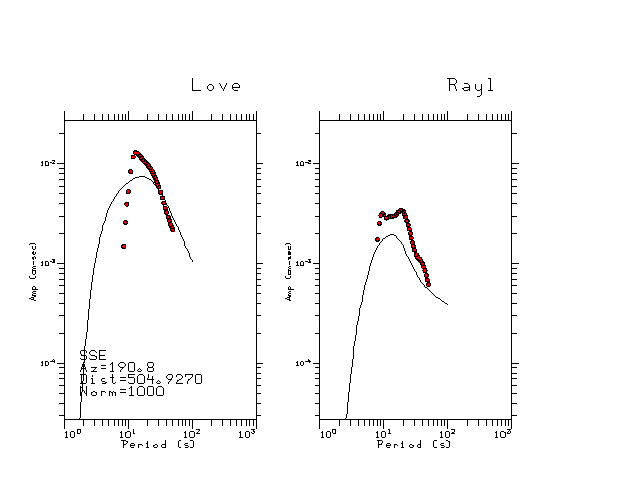 |
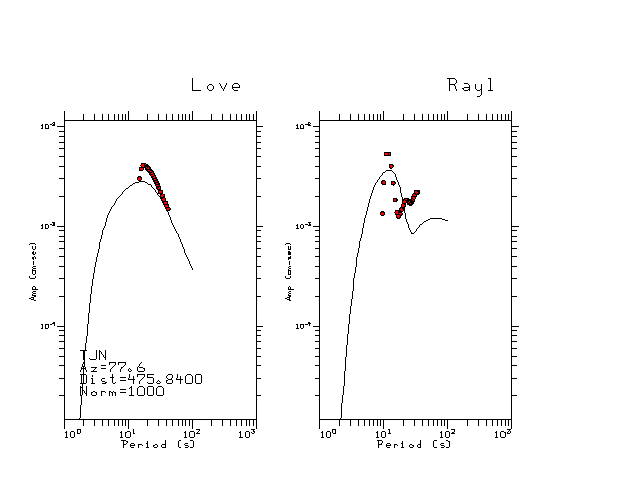 |
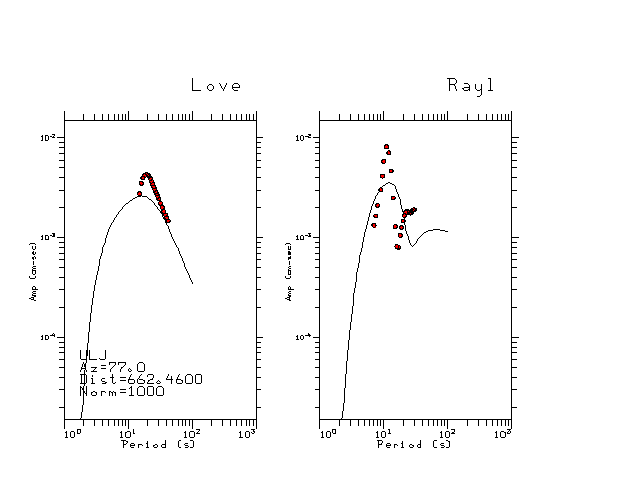 |
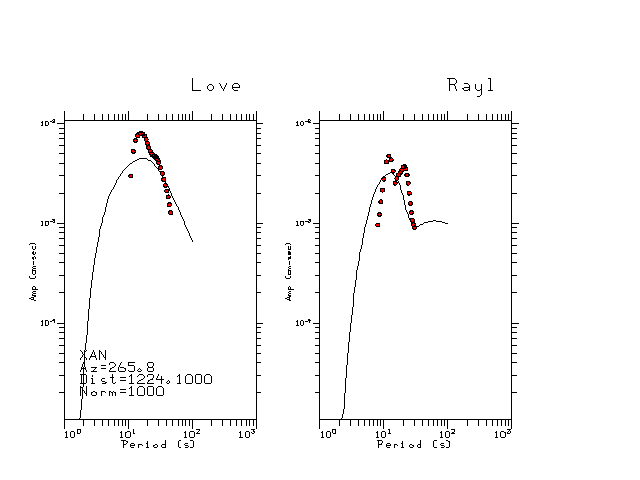 |
Here we tabulate the reasons for not using certain digital data sets